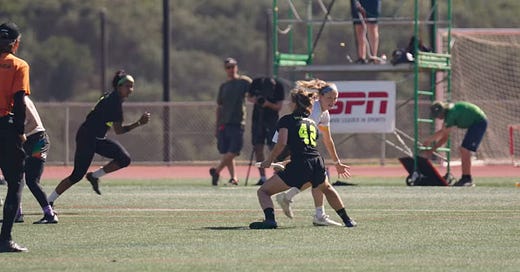When your pump fake becomes your juke
Cutting threats make throwing easier
I love this moment from BE Ultimate's Levke Walczak: Journey to a Championship:
Levke pump fakes a right-handed backhand to the open side, and her defender bites so hard that Levke has the entire break side wide open to throw to.
In fact, you can hardly even call it a "pump fake". The disc starts by her left hip, and ends up by her right knee. Far from a complete "throwing motion".
What she's threatening here isn't just throwing the disc. She's threatening to give-and-go.
A very successful frisbee coach once told me that we shouldn't call it a "throw and go", we should call it a "go and throw". To me, this Levke clip really exemplifies the idea of go and throw. Look how much momentum she's built up towards an open side give-and-go without even releasing the disc. If you're marking her, you can't afford to wait for her to release the disc to start building up your own momentum. By that time, it would be too late—she's already running, and you're not.
Like, I'm not even sure the defender is playing bad defense here. Wait any longer to start gaining momentum and Levke is gaining big yards. Might as well take the risk that there's no one currently open for a devastating break throw.
(And while I've seen a clip or two of Levke traveling before, she doesn't really travel here. OK, maybe the left foot slides a tiny bit, but to me she makes an honest effort to keep it pinned to the ground, and that amount of sliding is basically allowed under current rules.)
I don't take credit for these ideas. Noted frisbee internet troll Frank H wrote an article last year on the "triple threat" in ultimate:
The three threats in ultimate are passing, scoring and shredding...
In other words...the whole point of Shredding is to prioritize placing a significant emphasis on the threat of dribble-drive-penetration consciously within the minds of the defenders 💯 of the time...all I have to do is show it as a perpetual threat and that’s all that’s needed to apply a lever to the defense and get them to back off.
I'm not really a fan of Frank's writing and I can't really recommend you read the whole article. And I think trying to make "passing" and "scoring" into two different legs of the triple threat is non-sensical (he tries to explain it, but I don't find his explanation compelling...)1
But I do think there's one thing he's totally right about: when you're a big enough threat to start cutting after you throw, it fundamentally changes how the defense can play you:
A smart defender won't sell out to stop your dump throws when they know overplaying there will end in you getting open downfield.
Generally, mark defenders are able to be overactive against throwers in the current ultimate frisbee 'meta', because throwers don't make them pay for overplaying certain threats.
As we learned from Levke: If you can build up momentum before you've even released the disc, a smart defender will be forced to do the same if they don't want to get burned.
Or to put it another way: the threat of an explosive open side give-and-go can open up the entire breakside.
To tie it back to the title of this article: an (over)active mark defender isn't a challenge to throw around, they're an opportunity for getting open as a cutter. Learn to see the cutting opportunities that are created by what you and your mark are doing while the disc is still in your hands.
Once you've proven you can do that, a good defender will let you have more easy throws, in order to prevent you from having more easy give-and-gos.
Being in "athletic position" as a thrower immediately makes you a bigger threat. More people should look like this while holding the disc:
Frisbee players by and large still tend to think of throwing a pass as the end of their job. But there's a lot to be gained by thinking of throwing as just the beginning of your job. It's undoubtedly a harder way to play frisbee in some ways, but it can make throwing much easier when the defense is forced to respect the threats you present.
He says, essentially, that throwing to different parts of the field puts different types of pressure on the defense. Which is true—I've written about having options a lot myself—but it almost proves too much. Every different spot on the field you could pass to are different "threats" under that paradigm.



I fear going hard no around now because of that one time I did it while marking a fast player who pivoted for an around break then back to the open side, threw something and bolted downfield and scored after one or two other throws. Absolutely roasted me. No help from the team. Moving the mark to throw and go is an excellent idea. But can't say I often see someone getting as free to the break side as Levke in this clip. Nice find!